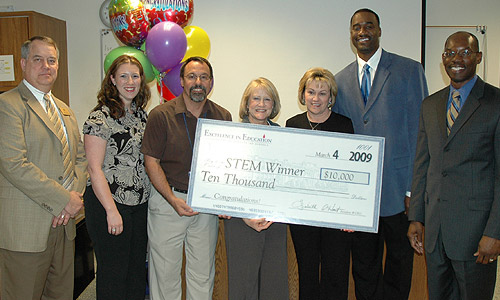Feature: Defying Tradition
 Kevin Cieszkowski sounds like a glutton for punishment. “Students hit me with a sledge hammer, watch a bowling ball swing towards my face and see me lie on a bed of nails,” says the Richardson, Tex. physics teacher. “And that’s only the first semester.”
Kevin Cieszkowski sounds like a glutton for punishment. “Students hit me with a sledge hammer, watch a bowling ball swing towards my face and see me lie on a bed of nails,” says the Richardson, Tex. physics teacher. “And that’s only the first semester.”
In fact, he usually survives unscathed, thanks to the wonders of physics, and that’s the point of such demonstrations. As students watch in suspense, he’s able to convey key scientific concepts underlying those wonders that might otherwise be hard for a class to grasp.
A 25-year educator, Cieszkowski began classroom teaching only five years ago. Before that, he was an adventure instructor, using high-ropes and rock climbing to teach students cooperation, self-esteem, and communication. Nontraditional teaching techniques continue to serve him well. In August, he was one of 10 teachers to receive a $10,000 award from Texas Instruments, the electronics company, for innovations in STEM (Science, Technology, Engineering, and Math) teaching.

Everyday life provides much of the material for Cieszkowski’s lessons. He uses things that students can relate to, such as toys or their favorite activities, exploring the physics behind the familiar. He has students build musical instruments and Rube Goldberg contraptions, the comically complex – and totally unnecessary – machines that perform ordinary, simple tasks. Technology strikes home with today’s students, he has found. Using the remote device for the video-game system Wii, for instance, he can explain infrared light and accelerometers.
When he lies on a bed of nails, students learn about key physics concepts. Even if a cinder block is placed on top of him and then smashed with a sledgehammer, the sharp nails still won’t penetrate his skin because his weight and pressure are evenly distributed over thousands of points. The nails only become dangerous when pressure is applied to a few points, such as if he stood barefoot on them. As for the bowling ball, which is fixed like a pendulum to the ceiling by a chain or cable, Cieszkowski holds it near to his face and then lets it go. The bowling ball swings away and then hurtles back toward his face, but never obtains the same height as before. This exercise teaches students about velocity, as well as energy conservation and potential.
Berkner STEM Academy, where Cieszkowski teaches, seems a good fit for an instructor eager to excite students. An academy within the 2,800-student public Berkner High School, it emphasizes flexible learning. It is one of the T-STEM schools developed as part of the public-private, college-preparatory Texas High School Project.
Alex Brown, a former student of Cieszkowski’s, says, “One of the things I loved so much about Mr. C’s class was how passionate he was. If you just listen to him when he talks, you can tell that he loves his job. And, when someone loves something that much, it rubs off on the people around them.”
Cieszkowski’s demonstrations and projects do not end in the classroom. Along with AP Physics teacher John Frensley, he started an innovative physics club, where students take apart motors to see how they work, compete to build the best catapult, chair made of newspaper, or cardboard boat. Members, who are called vice president if they attend 90 percent of the meetings, also hold their own demonstrations to get elementary school kids interested in physics.
He devotes considerable time to sharing his techniques with other educators. He does more than 200 presentations for teachers a year, both through a district-wide effort and statewide conferences such as the “2009 [Texas]-STEM Best Practices Conference.” He encourages his fellow physics teachers to incorporate at least three demonstrations a week in their classes.
“I’m a firm believer that people learn best by doing things,” Cieszkowski says, “This makes the learning fun, and I rarely feel that I need to engage the students – the concepts engage the students.”
Filed under: Special Features








